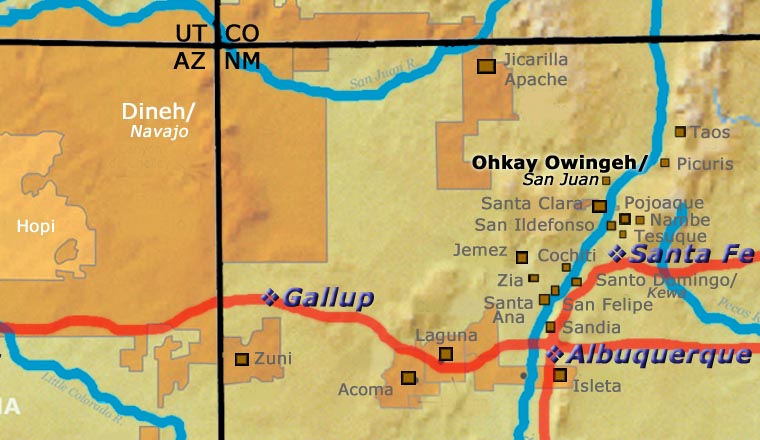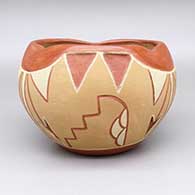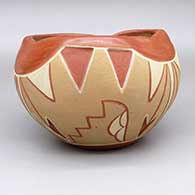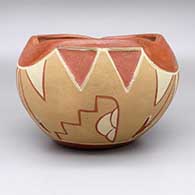
Tomasita Reyes Montoya
Ohkay Owingeh(San Juan)
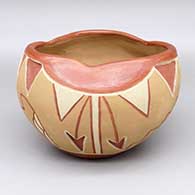
Tomasita Reyes Montoya was born into Ohkay Owingeh in February 1899 and passed on in May 1978. She became of the seven original potters of the Ohkay Owingeh pottery revival in the 1930s. She was active as a potter from the early 1930s until she died. She mostly made incised polychrome redware bowls, jars and vases. Some of those included fine line designs. She also made some micaceous jars and bowls and used micaceous clays to decorate some of her incised pots.
By the early 1930s, most arts and crafts at Ohkay Owingeh had almost died out. In the early 1930s a group of eight women came together to try to revive something. At first they started with embroidery. Then they learned about some pre-contact pottery that had been found in a dig on the west side of the Rio Grande on Ohkay Owingeh land. From that pottery those women distilled a form and style for the making of original Ohkay Owingeh pottery (pre-contact with the Spanish). They named it Potsuwi'i, after the ancient pueblo where it had first been found. Of those original eight women in the group, seven became potters.
As they were growing up, Tomasita taught her daughters, Rosita de Herrera and Dominguita Sisneros Naranjo, how to make Potsuwi'i pottery, too.
100 West San Francisco Street, Santa Fe, New Mexico 87501
(505) 986-1234 - www.andreafisherpottery.com - All Rights Reserved

Ohkay Owingeh (San Juan)
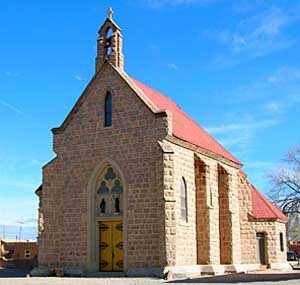
Ohkay Owingeh Mission
In 2005 San Juan Pueblo officially changed its name back to the original name (before the Spanish arrived): Ohkay Owingeh (meaning: Place of the strong people). The pueblo was founded around 1200 AD during the time of the great Southwest drought and migrations. The people speak Tewa and may have come to the Rio Grande area from southwestern Colorado or from the San Luis Valley in central Colorado.
Spanish conquistador Don Juan de Oñate took control of the pueblo in 1598, renaming it San Juan de los Caballeros (after his patron saint, John the Baptist). He established the first Spanish capitol of Nuevo Mexico across the Rio Grande in an area he named San Gabriel. In 1608, the capitol was moved south to an uninhabited area that became the Santa Fe we know today.
After 80 years of progressively deteriorating living conditions under the Spanish, the tribe participated in the Pueblo Revolt of 1680 (one of the revolt's ringleaders, Popé, was an Ohkay Owingeh native) and helped to expel the Spanish from Nuevo Mexico for 12 years. However, when the Spanish returned in 1692 that tribal unity had fallen apart and the individual pueblos were relatively easy for the Spanish to reconquer.
Today, Ohkay Owingeh is the largest Tewa-speaking pueblo (in population and land) but few of the younger generations are interested in carrying on with many of the tribe's traditional arts and crafts (such as the making of pottery). The pueblo is home to the Eight Northern Indian Pueblos Council, the Oke-Oweenge Arts Cooperative, the San Juan Lakes Recreation Area and the Ohkay Casino & Resort. The tribe's Tsay Corporation is one of northern New Mexico's largest private employers.
100 West San Francisco Street, Santa Fe, New Mexico 87501
(505) 986-1234 - www.andreafisherpottery.com - All Rights Reserved

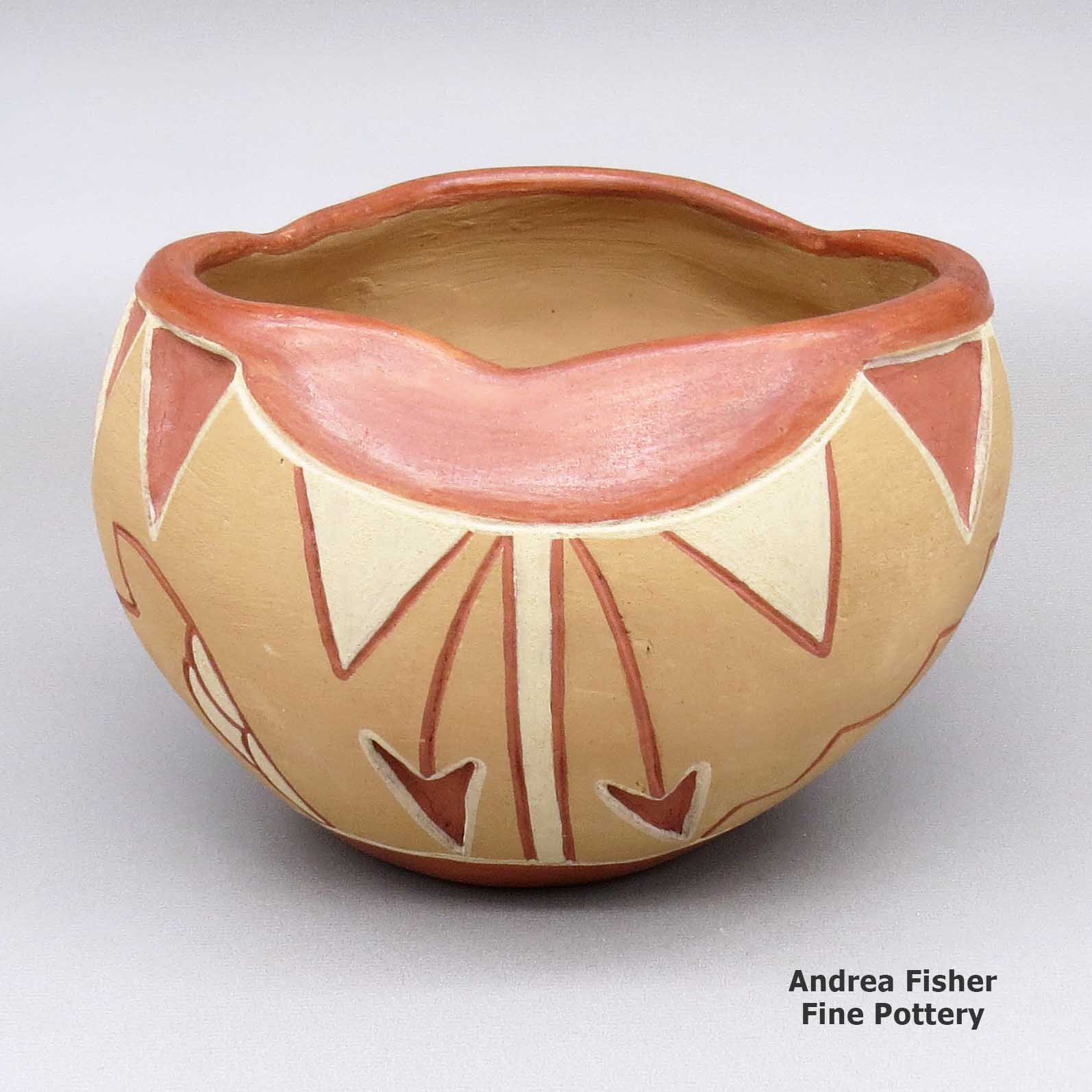
Tomasita Reyes Montoya, Ohkay_Owingeh, Polychromejarwithanorganicopeningandalightlycarvedandpaintedraincloudandgeometricdesign
Ohkay Owingeh
$ 375
cjsj3c221
Polychrome jar with an organic opening and a lightly carved and painted raincloud and geometric design
6.5 in L by 6.5 in W by 4.75 in H
Condition: Very good, rubbing and scratching on bottom
Signature: Tomasita Montoya
100 West San Francisco Street, Santa Fe, New Mexico 87501
(505) 986-1234 - www.andreafisherpottery.com - All Rights Reserved

Tomasita Reyes Montoya Family Tree
Disclaimer: This "family tree" is a best effort on our part to determine who the potters are in this family and arrange them in a generational order. The general information available is questionable so we have tried to show each of these diagrams to living members of each family to get their input and approval, too. This diagram is subject to change should we get better info.
- Tomasita Reyes Montoya (1899-1978) and Juan Reyes Montoya
- Dominguita Naranjo (Sisneros)(1942-) and Juan Sisneros
- Jennifer Sisneros and Alfred E. Naranjo (Santa Clara)
- Alfred J. Naranjo
- Jeannette Teba and Steven Teba Sr.
- Steven Teba Jr.
- Veronica Teba
- Jennifer Sisneros and Alfred E. Naranjo (Santa Clara)
- Rosita de Herrera
- Norman de Herrera
Some of the above info is drawn from Pueblo Indian Pottery, 750 Artist Biographies, by Gregory Schaaf, © 2000, Center for Indigenous Arts & Studies
Other info is derived from personal contacts with family members and through interminable searches of the Internet.
(505) 986-1234 - www.andreafisherpottery.com - All Rights Reserved
